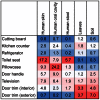Home life: factors structuring the bacterial diversity found within and between homes
- PMID: 23717552
- PMCID: PMC3661444
- DOI: 10.1371/journal.pone.0064133
Home life: factors structuring the bacterial diversity found within and between homes
Abstract
Most of our time is spent indoors where we are exposed to a wide array of different microorganisms living on surfaces and in the air of our homes. Despite their ubiquity and abundance, we have a limited understanding of the microbial diversity found within homes and how the composition and diversity of microbial communities change across different locations within the home. Here we examined the diversity of bacterial communities found in nine distinct locations within each of forty homes in the Raleigh-Durham area of North Carolina, USA, using high-throughput sequencing of the bacterial 16S rRNA gene. We found that each of the sampled locations harbored bacterial communities that were distinct from one another with surfaces that are regularly cleaned typically harboring lower levels of diversity than surfaces that are cleaned infrequently. These location-specific differences in bacterial communities could be directly related to usage patterns and differences in the likely sources of bacteria dispersed onto these locations. Finally, we examined whether the variability across homes in bacterial diversity could be attributed to outdoor environmental factors, indoor habitat structure, or the occupants of the home. We found that the presence of dogs had a significant effect on bacterial community composition in multiple locations within homes as the homes occupied by dogs harbored more diverse communities and higher relative abundances of dog-associated bacterial taxa. Furthermore, we found a significant correlation between the types of bacteria deposited on surfaces outside the home and those found inside the home, highlighting that microbes from outside the home can have a direct effect on the microbial communities living on surfaces within our homes. Together this work provides the first comprehensive analysis of the microbial communities found in the home and the factors that shape the structure of these communities both within and between homes.
Conflict of interest statement
Figures




References
-
- Berglund B, Brunckreef B, Knoppel H, Lindvall T, Maroni M, et al. (1992) Effects of indoor air pollution on human health. Indoor Air 2: 2–25.
-
- Burge H (1990) Bioaerosols: Prevalence and health effects in the indoor environment. Journal of Allergy and Clinical Immunology 86: 687–701. - PubMed
-
- Portnoy JM, Kwak K, Dowling P, VanOsdol T, Barnes C (2005) Health effects of indoor fungi. Annals of Allergy, Asthma, and Immunology 94: 313–319. - PubMed
Publication types
MeSH terms
Substances
Grants and funding
LinkOut - more resources
Full Text Sources
Other Literature Sources
Molecular Biology Databases

